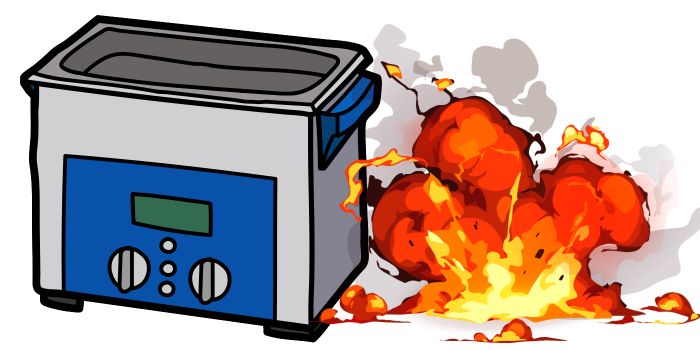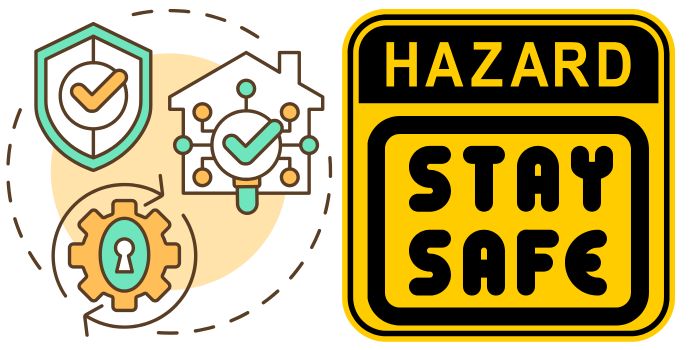
Explosion-proof ultrasonic cleaners are ideal for cleaning difficult-to-clean industrial items that cannot be sanitized through more conventional methods.
These cleaners use flammable solvents to provide a deep cleaning action to the items that are heavily covered with contaminants.
Unlike traditional, water-based cleaning methods and devices, explosion-proof ultrasonic cleaners work with hazardous materials that must be handled carefully.
If you are working in an environment that requires the use of an ultrasonic cleaner, it’s important to understand the nature of flammable materials, the limitations, and the purpose of the cleaners being used.
As such, this guide can prove helpful in knowing better about explosion-proof ultrasonic cleaners that are safe to work with flammable liquids.
Let’s take a detailed look at the different working components of these ultrasonic cleaners and how they come together to provide a quality clean.
What is a Flammable Liquid?

A flammable liquid is defined as any liquid that has a flashpoint below 100 degrees Fahrenheit (or 38.7 degrees Celsius). Well, that sounds like a technical definition, so let’s break it down…
In layman’s terms, a flammable liquid will easily catch fire. This generally occurs when the flashpoint of a liquid (or the temperature at which a liquid will burn) is low.
For ease of use, we classify any low temperatures in this context as up to 100 degrees Fahrenheit. Flammable liquids can, therefore, catch fire at any temperature below this point.
How does this happen?
Simply put, it’s not the liquid that ignites. Instead, the vapor or gas is given off from the liquid.
Flammable liquids will give off this gas at a temperature of 100 degrees Fahrenheit or below, making them more susceptible to ignition.
This is why flammable liquids are generally stored in special environments and why it’s never advised for you to keep highly flammable materials out in the open.
The Need for Explosion-Proof Ultrasonic Cleaners
Ultrasonic cleaners convert electrical energy into sound waves that create cavitation action through the bubbles in the solvent. When this occurs, contaminant molecules clinging to your cleaning product break off and clear away.
This revolutionary cleaning method has helped clean a variety of items such as jewelry, auto parts, tools, etc. But what we’ve just described is the standard form of ultrasonic cleaning where these cleaners use water-based solvents to clean materials.
Flammable solvents have long been unavailable for ultrasonic cleaning. This is because the mechanisms that run traditional ultrasonic cleaning devices could trigger the flash-point of flammable solvents and cause the machine to explode.
Technological advancements, however, have allowed upgraded, ultrasonic cleaners to come into the market simply because these explosion-proof devices provide a more efficient clean by using flammable solvents. This is in large part due to their propensity to evaporate quickly.
Explosion-Proof Ultrasonic Cleaners – Industries They Serve
In a typical benchtop unit, the transducer assembly, generator circuitry, and heater elements are not sealed or explosion-proof, meaning any stray spark, hot spot, or electrical arc can ignite these vapors.
Explosion-proof ultrasonic cleaners, on the other hand, can incorporate flammable solvents such as isopropyl alcohol (IPA), acetone, toluene, MEK, or gasoline and provide deep cleaning to materials that cannot be cleaned by human hands.
These explosion-proof ultrasonic cleaners are known for their wide range of applicability and their many uses might surprise you.
Generally, they are employed for hard-to-clean items, such as X-ray tubes, pressure regulators, and printer parts but you can also clean medical supplies, antiques, surgical implants, nozzles used for powder coating, and many other smaller parts that are too tiny for human hands.
Whether it’s degreasing machine parts, removing wax from molds, or cleaning polymer residues from precision tools, these cleaners provide an efficient and reliable solution for handling materials that are typically insoluble in water.

Safety Precautions when Using Flammable Solvents in a Sonic Cleaner
When utilizing an explosion-proof ultrasonic cleaning method, electrical safety is crucial.
The high-frequency sound waves used in this process require that all electrical equipment be either disconnected or properly shielded to prevent contact with water.
If you are using flammable liquids in a device equipped with a blast-proof ultrasonic tank, ensure that the device is placed and operated in a well-ventilated area to mitigate the risk posed by the fumes released during the cleaning process.
Moreover, proper dilution of solvents is crucial for achieving optimal results. Users should always consult the owner’s manual to ensure they follow the correct safety protocols, concentration levels, and usage instructions.
It is also important to remember that these liquids are hazardous and necessitate special safety precautions in the workplace. For instance:
- Always wear suitable personal protective equipment (PPE), including gloves, safety goggles, respiratory protection, and flame-resistant clothing.
- Furthermore, the workspace should remain dry and free from combustible materials like oil or grease.
- Store flammable liquids in approved, clearly labeled containers, keeping them away from heat sources or open flames.
- Keep fire extinguishers rated for flammable liquids easily accessible in the area.
- Conduct regular inspections of the ultrasonic tank and associated equipment to detect and prevent leaks or malfunctions.
Also, be aware that certain products may be incompatible with flammable solvents and should be cleaned exclusively with aqueous-based solutions.
In certain cases, it may be necessary to degas the solvents used to avoid the formation of hazardous vapors. This can be achieved by introducing an inert gas, such as nitrogen or argon, into the mixture before initiating the cleaning process.

How to Select the Best Ultrasonic Cleaner Device for Flammable Solvents?
Which ultrasonic cleaner you need for using flammable fluids and solutions depends on a few important factors.
Let’s examine each of these so that you can make the most informed decision.
1- Size:
First, you need to consider the scope of your project. If you are cleaning large items or many items at once, you will need a more heavy-duty cleaner that is equipped to deal with large-scale cleaning tasks.
If you don’t require this level of cleaning, however, smaller portable-sized machines will work for you.
2- Solvents used:
Some solvents can release hazardous vapor clouds if heated beyond a certain temperature.
So, it’s essential to consider the solvent’s flashpoint and ensure that the explosion-proof ultrasonic cleaner you choose is certified for use with the specific solvent and is safe even when cleaning application involves the release of hazardous gases.
3- Code and Zoning Requirements:
Before ordering your cleaner, you should check up on all relevant code and zoning requirements to ensure that the machine you buy is compliant.
And while you’re at it, take a look at how it drains while making sure your cleaner’s power requirements match your electrical system—no one likes a shocker (unless it’s a good one).
Some models come with handy drain valves or pumps for easy draining and refilling, while others might let you plug directly into a water source or feature a built-in filtration system for that extra touch of efficiency.
Oh, and be sure to peek at those warranties. They’re the manufacturers’ way of saying, “We’ve got your back!” in case anything goes awry down the road with your explosion-proof ultrasonic cleaning machine.
